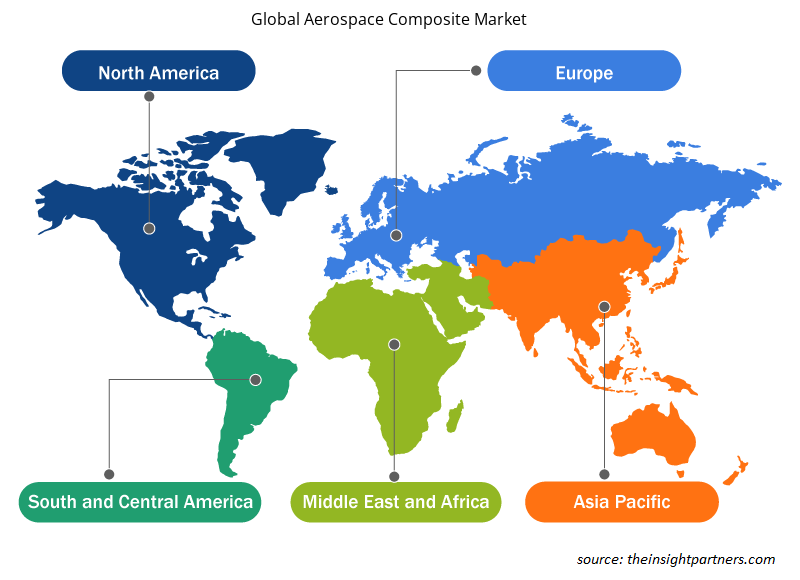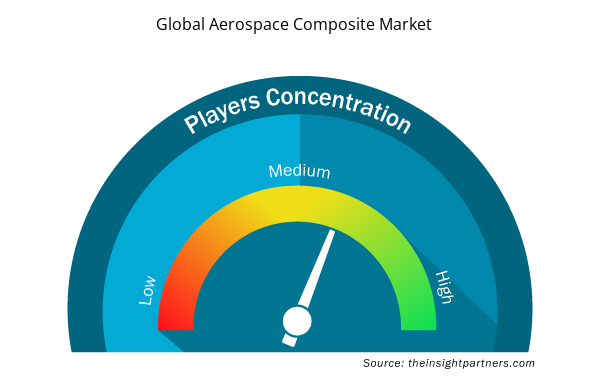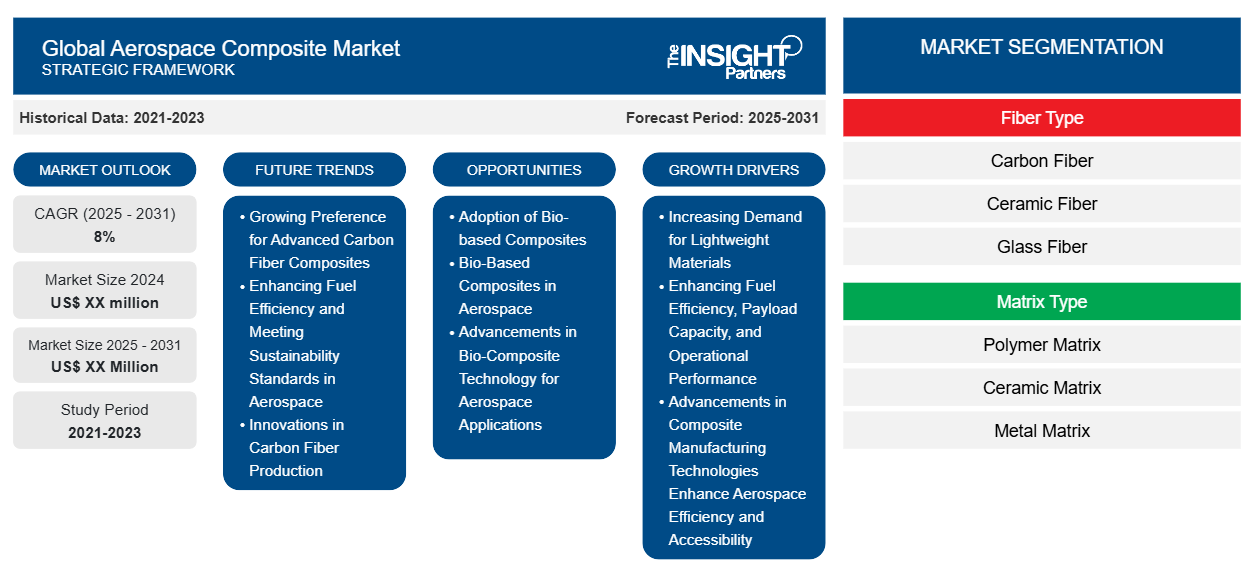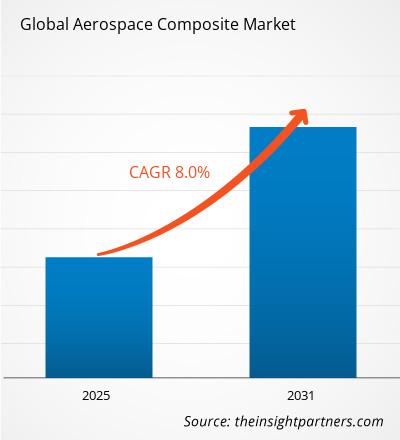Es wird erwartet, dass der Markt für Verbundwerkstoffe für die Luft- und Raumfahrt von 2023 bis 2031 eine durchschnittliche jährliche Wachstumsrate (CAGR) von 8 % verzeichnet , wobei die Marktgröße von XX Millionen US-Dollar im Jahr 2023 auf XX Millionen US-Dollar im Jahr 2031 anwachsen wird.
Der Bericht ist nach Fasertyp (Kohlefaser, Keramikfaser, Glasfaser und andere) segmentiert. Der Bericht präsentiert außerdem eine Analyse basierend auf dem Matrixtyp (Polymermatrix, Keramikmatrix und Metallmatrix). Basierend auf der Technologie ist der Bericht segmentiert in (Lay-Up, Harztransferformung, Filamentwicklung und andere). Basierend auf der Anwendung ist der Bericht segmentiert in (Innen- und Außenbereich). Die globale Analyse ist weiter auf regionaler Ebene und in den wichtigsten Ländern aufgeschlüsselt. Der Bericht bietet den Wert in USD für die oben genannte Analyse und Segmente.
Zweck des Berichts
Der Bericht Aerospace Composite Market von The Insight Partners zielt darauf ab, die aktuelle Landschaft und das zukünftige Wachstum sowie die wichtigsten treibenden Faktoren, Herausforderungen und Chancen zu beschreiben. Dies wird verschiedenen Geschäftspartnern Einblicke geben, wie zum Beispiel:
- Technologieanbieter/-hersteller: Um die sich entwickelnde Marktdynamik zu verstehen und die potenziellen Wachstumschancen zu kennen, damit sie fundierte strategische Entscheidungen treffen können.
- Investoren: Durchführung einer umfassenden Trendanalyse hinsichtlich der Marktwachstumsrate, der finanziellen Marktprognosen und der Chancen entlang der Wertschöpfungskette.
- Regulierungsbehörden: Zur Regulierung von Richtlinien und Überwachungsaktivitäten auf dem Markt mit dem Ziel, Missbrauch zu minimieren, das Vertrauen der Anleger zu bewahren und die Integrität und Stabilität des Marktes aufrechtzuerhalten.
Marktsegmentierung für Verbundwerkstoffe für die Luft- und Raumfahrt
Fasertyp
- Kohlefaser
- Keramikfaser
- Glasfaser
Matrixtyp
- Polymermatrix
- Keramische Matrix
- Metallmatrix
Technologie
- Auflegen
- Harztransferformung
- Filamentwicklung
Geographie
- Nordamerika
- Europa
- Asien-Pazifik
- Süd- und Mittelamerika
- Naher Osten und Afrika
Geographie
- Nordamerika
- Europa
- Asien-Pazifik
- Süd- und Mittelamerika
- Naher Osten und Afrika
Passen Sie diesen Bericht Ihren Anforderungen an
Sie erhalten kostenlose Anpassungen an jedem Bericht, einschließlich Teilen dieses Berichts oder einer Analyse auf Länderebene, eines Excel-Datenpakets sowie tolle Angebote und Rabatte für Start-ups und Universitäten.
- Holen Sie sich die wichtigsten Markttrends aus diesem Bericht.Dieses KOSTENLOSE Beispiel umfasst eine Datenanalyse von Markttrends bis hin zu Schätzungen und Prognosen.
Wachstumstreiber auf dem Markt für Verbundwerkstoffe in der Luft- und Raumfahrt
- Steigende Nachfrage nach Leichtbauwerkstoffen: Das Gesamtwachstum auf dem Markt für Verbundwerkstoffe in der Luft- und Raumfahrt wird maßgeblich durch eine steigende Nachfrage nach Leichtbauwerkstoffen begünstigt. Angesichts der steigenden Anforderungen an Kraftstoffeffizienz und geringere Emissionen versucht die Luft- und Raumfahrtindustrie aggressiv, Gewicht zu verlieren. Leichtbauwerkstoffe sind aufgrund ihres hervorragenden Verhältnisses von Festigkeit zu Gewicht die ideale Lösung für diese Anforderung in der Luft- und Raumfahrtindustrie. Dadurch können Flugzeughersteller optimale Leistung aufrechterhalten und gleichzeitig die Betriebskosten senken.
- Verbesserung der Treibstoffeffizienz, der Nutzlastkapazität und der Betriebsleistung: Neben der besseren Treibstoffeffizienz erhöhen leichte Verbundwerkstoffe auch die Nutzlastkapazität. Die Möglichkeit, das Gesamtgewicht eines Flugzeugs zu reduzieren, bedeutet, dass mehr Fracht oder in manchen Fällen mehr Passagiere befördert werden können – ein wesentlicher Gewinnbringer. Der Trend zu immer höherer Betriebseffizienz zwingt Luft- und Raumfahrtunternehmen, in fortschrittliche Verbundwerkstoffe zu investieren, vor allem in neue Flugzeugkonstruktionen, aber auch in die Nachrüstung ihrer bestehenden Konstruktionen.
- Fortschritte in der Verbundwerkstoff-Fertigungstechnologie verbessern Effizienz und Zugänglichkeit in der Luft- und Raumfahrt: Die Fortschritte in der Verbundwerkstoff-Fertigungstechnologie ermöglichen auch die Herstellung von Leichtbaustoffen. Weitere Innovationen im Zusammenhang mit automatisierter Faserplatzierung und Harzinfusionsprozessen haben nicht nur die Effizienz, sondern auch die Qualität von Verbundwerkstoffkomponenten verbessert. Dadurch werden Verbundwerkstoffe für Hersteller in vielen Luft- und Raumfahrtanwendungen zugänglicher.
Zukünftige Trends auf dem Markt für Verbundwerkstoffe in der Luft- und Raumfahrt
- Wachsende Vorliebe für moderne Kohlefaserverbundstoffe: Der Trend zu neuen Kohlefasermaterialien der nächsten Generation gewinnt auf dem Markt für Verbundwerkstoffe in der Luft- und Raumfahrt immer mehr an Bedeutung. Diese neuen Materialien sind besser als ihre Vorgänger und verfügen über eine höhere Festigkeit, Haltbarkeit und hervorragende Eigenschaften, um extremen Temperaturen standzuhalten – Testqualitäten, die sich gut für anspruchsvolle Anwendungen in der Luftfahrtindustrie eignen. Kohlefaserverbundstoffe werden langsam auch in Flugzeugen eingesetzt, wobei die Hersteller auf jede mögliche Verbesserung drängen.
- Verbesserung der Treibstoffeffizienz und Einhaltung von Nachhaltigkeitsstandards in der Luft- und Raumfahrt: Kohlenstofffasern der nächsten Generation sind sehr leicht, aber dennoch stärker und robuster als die vorherige Generation und bieten eine deutlich höhere Treibstoffeffizienz bei weniger Emissionen. Dies ist von entscheidender Bedeutung, da die Luft- und Raumfahrtindustrie nun erkennt, dass die Trends zu Nachhaltigkeit und Umweltschutz viel strengere Vorschriften für eine umweltfreundlichere Luftfahrt bedeuten. Daher können Hochleistungsflugzeuge entwickelt werden, bei deren Design fortschrittliche Fasern verwendet werden, um die Emissionsvorschriften einzuhalten.
- Innovationen in der Carbonfaserproduktion: Darüber hinaus steigt die Marktnachfrage aufgrund von Innovationen bei den Produktionsmethoden für Carbonfasern. Die Verbesserung der Herstellungsverfahren, wie beispielsweise der Endlosfaserproduktion, verbessert die Konsistenz und Qualität des Carbonfasermaterials. Verbesserungen durch diese Entwicklungen ermöglichen es den Herstellern in der Luft- und Raumfahrt, Carbonfasern an komplexe Komponenten anzupassen. Folglich werden Carbonfasern in der Industrie immer häufiger eingesetzt.
Marktchancen für Verbundwerkstoffe in der Luft- und Raumfahrt
- Einführung biobasierter Verbundwerkstoffe: Biobasierte Verbundwerkstoffe bieten zunehmend Wachstumschancen für den Markt für Verbundwerkstoffe in der Luft- und Raumfahrt. Aufgrund zunehmender Umweltbedenken suchen Luft- und Raumfahrtunternehmen derzeit nach nachhaltigen Materialien, um den CO2-Fußabdruck der Branche zu verringern. Aufgrund ihres Ursprungs aus erneuerbaren Ressourcen sind biobasierte Verbundwerkstoffe umweltfreundlich und offensichtlich weitaus nachhaltiger als erdölbasierte Produkte, die die Grundlage dieses herkömmlichen Produkts bilden.
- Biobasierte Verbundwerkstoffe in der Luft- und Raumfahrt: Diese Verbundwerkstoffe besitzen gute Eigenschaften; sie zeichnen sich durch ein hohes Verhältnis von Festigkeit zu Gewicht und eine verbesserte mechanische Leistung aus. Das geringe Gewicht erhöht die Treibstoffeffizienz von Flugzeugen; daher wird dies von Herstellern beachtet, die bestrebt sind, effizient zu arbeiten und die Umweltgesetze einzuhalten. Ihr Bedarf an nachhaltiger Leistung führt zur Einführung dieser biobasierten Verbundwerkstoffe.
- Fortschritte in der Bioverbundstofftechnologie für Luft- und Raumfahrtanwendungen: Weitere Entwicklungen in der Bioverbundstofftechnologie erhöhen deren Einsatzmöglichkeiten in der Luft- und Raumfahrt. Weitere Entwicklungen in neuen Harzformulierungen und Verstärkungstechniken können ihre Haltbarkeit und thermische Stabilität verbessern. Verbesserte Forschung fördert die Möglichkeit biobasierter Verbundstoffe für kritische Luft- und Raumfahrtteile und steigert so die Nachfrage auf dem Markt weiter.
Globale Einblicke in den regionalen Markt für Verbundwerkstoffe für die Luft- und Raumfahrt
Die regionalen Trends und Faktoren, die den globalen Markt für Verbundwerkstoffe für die Luft- und Raumfahrt im Prognosezeitraum beeinflussen, wurden von den Analysten von Insight Partners ausführlich erläutert. In diesem Abschnitt werden auch die globalen Marktsegmente und die Geografie des Marktes für Verbundwerkstoffe für die Luft- und Raumfahrt in Nordamerika, Europa, im asiatisch-pazifischen Raum, im Nahen Osten und Afrika sowie in Süd- und Mittelamerika erörtert.

- Erhalten Sie regionalspezifische Daten zum globalen Markt für Verbundwerkstoffe für die Luft- und Raumfahrt
Umfang des globalen Marktberichts zu Verbundwerkstoffen für die Luft- und Raumfahrt
| Berichtsattribut | Details |
|---|---|
| Marktgröße im Jahr 2023 | XX Millionen US-Dollar |
| Marktgröße bis 2031 | XX Millionen US-Dollar |
| Globale CAGR (2023 - 2031) | 8 % |
| Historische Daten | 2021-2022 |
| Prognosezeitraum | 2024–2031 |
| Abgedeckte Segmente | Nach Fasertyp
|
| Abgedeckte Regionen und Länder | Nordamerika
|
| Marktführer und wichtige Unternehmensprofile |
|
Dichte der Akteure auf dem globalen Markt für Verbundwerkstoffe für die Luft- und Raumfahrt: Die Auswirkungen auf die Geschäftsdynamik verstehen
Der globale Markt für Verbundwerkstoffe für die Luft- und Raumfahrt wächst rasant. Dies wird durch die steigende Nachfrage der Endnutzer aufgrund von Faktoren wie sich entwickelnden Verbraucherpräferenzen, technologischen Fortschritten und einem größeren Bewusstsein für die Vorteile des Produkts vorangetrieben. Mit der steigenden Nachfrage erweitern Unternehmen ihr Angebot, entwickeln Innovationen, um die Bedürfnisse der Verbraucher zu erfüllen, und nutzen neue Trends, was das Marktwachstum weiter ankurbelt.
Die Marktteilnehmerdichte bezieht sich auf die Verteilung der Firmen oder Unternehmen, die in einem bestimmten Markt oder einer bestimmten Branche tätig sind. Sie gibt an, wie viele Wettbewerber (Marktteilnehmer) in einem bestimmten Marktraum im Verhältnis zu seiner Größe oder seinem gesamten Marktwert präsent sind.
Die wichtigsten auf dem globalen Markt für Verbundwerkstoffe für die Luft- und Raumfahrt tätigen Unternehmen sind:
- Allgemeine Elektrik
- Hexcel Corporation
- Materion Corporation
- Mitsubishi Rayon Co. Ltd
- Renegade Materials Corporation
Haftungsausschluss : Die oben aufgeführten Unternehmen sind nicht in einer bestimmten Reihenfolge aufgeführt.

- Überblick über die wichtigsten Akteure auf dem globalen Markt für Verbundwerkstoffe für die Luft- und Raumfahrt
Wichtige Verkaufsargumente
- Umfassende Abdeckung: Der Bericht deckt die Analyse von Produkten, Dienstleistungen, Typen und Endbenutzern des Marktes für Verbundwerkstoffe für die Luft- und Raumfahrt umfassend ab und bietet einen ganzheitlichen Überblick.
- Expertenanalyse: Der Bericht basiert auf dem umfassenden Verständnis von Branchenexperten und Analysten.
- Aktuelle Informationen: Der Bericht stellt durch die Abdeckung aktueller Informationen und Datentrends Geschäftsrelevanz sicher.
- Anpassungsoptionen: Dieser Bericht kann angepasst werden, um spezifische Kundenanforderungen zu erfüllen und die Geschäftsstrategien optimal anzupassen.
Der Forschungsbericht zum Markt für Verbundwerkstoffe für die Luft- und Raumfahrt kann daher dabei helfen, die Branchensituation und Wachstumsaussichten zu entschlüsseln und zu verstehen. Obwohl es einige berechtigte Bedenken geben kann, überwiegen die allgemeinen Vorteile dieses Berichts tendenziell die Nachteile.
- Historische Analyse (2 Jahre), Basisjahr, Prognose (7 Jahre) mit CAGR
- PEST- und SWOT-Analyse
- Marktgröße Wert/Volumen – Global, Regional, Land
- Branche und Wettbewerbsumfeld
- Excel-Datensatz



Report Coverage
Revenue forecast, Company Analysis, Industry landscape, Growth factors, and Trends

Segment Covered
This text is related
to segments covered.

Regional Scope
North America, Europe, Asia Pacific, Middle East & Africa, South & Central America

Country Scope
This text is related
to country scope.
Häufig gestellte Fragen
Growing Preference for Advanced carbon fiber composites is expected to be the key market trends.
Based on geography, Asia Pacific held the largest share of the aerospace composite market.
Based on fiber type, glass fiber, is expected to witness the fastest growth during the forecast period
General Electric, Hexcel Corporation, Materion Corporation are some of the key players operating in the aerospace composite market
Increasing Demand for Lightweight Materials is driving the market growth
The Aerospace Composite Market is estimated to witness a CAGR of 8% from 2023 to 2031
Trends and growth analysis reports related to Chemicals and Materials : READ MORE..
The List of Companies
1. General Electric
2. Hexcel Corporation
3. Materion Corporation
4. Mitsubishi Rayon Co. Ltd
5. Renegade Materials Corporation
6. Royal Ten Cate
7. SGL Group
8. Solvay Group
9. Teijin Ltd.
10. Toray Industries Ltd.
The Insight Partners performs research in 4 major stages: Data Collection & Secondary Research, Primary Research, Data Analysis and Data Triangulation & Final Review.
- Data Collection and Secondary Research:
As a market research and consulting firm operating from a decade, we have published and advised several client across the globe. First step for any study will start with an assessment of currently available data and insights from existing reports. Further, historical and current market information is collected from Investor Presentations, Annual Reports, SEC Filings, etc., and other information related to company’s performance and market positioning are gathered from Paid Databases (Factiva, Hoovers, and Reuters) and various other publications available in public domain.
Several associations trade associates, technical forums, institutes, societies and organization are accessed to gain technical as well as market related insights through their publications such as research papers, blogs and press releases related to the studies are referred to get cues about the market. Further, white papers, journals, magazines, and other news articles published in last 3 years are scrutinized and analyzed to understand the current market trends.
- Primary Research:
The primarily interview analysis comprise of data obtained from industry participants interview and answers to survey questions gathered by in-house primary team.
For primary research, interviews are conducted with industry experts/CEOs/Marketing Managers/VPs/Subject Matter Experts from both demand and supply side to get a 360-degree view of the market. The primary team conducts several interviews based on the complexity of the markets to understand the various market trends and dynamics which makes research more credible and precise.
A typical research interview fulfils the following functions:
- Provides first-hand information on the market size, market trends, growth trends, competitive landscape, and outlook
- Validates and strengthens in-house secondary research findings
- Develops the analysis team’s expertise and market understanding
Primary research involves email interactions and telephone interviews for each market, category, segment, and sub-segment across geographies. The participants who typically take part in such a process include, but are not limited to:
- Industry participants: VPs, business development managers, market intelligence managers and national sales managers
- Outside experts: Valuation experts, research analysts and key opinion leaders specializing in the electronics and semiconductor industry.
Below is the breakup of our primary respondents by company, designation, and region:

Once we receive the confirmation from primary research sources or primary respondents, we finalize the base year market estimation and forecast the data as per the macroeconomic and microeconomic factors assessed during data collection.
- Data Analysis:
Once data is validated through both secondary as well as primary respondents, we finalize the market estimations by hypothesis formulation and factor analysis at regional and country level.
- Macro-Economic Factor Analysis:
We analyse macroeconomic indicators such the gross domestic product (GDP), increase in the demand for goods and services across industries, technological advancement, regional economic growth, governmental policies, the influence of COVID-19, PEST analysis, and other aspects. This analysis aids in setting benchmarks for various nations/regions and approximating market splits. Additionally, the general trend of the aforementioned components aid in determining the market's development possibilities.
- Country Level Data:
Various factors that are especially aligned to the country are taken into account to determine the market size for a certain area and country, including the presence of vendors, such as headquarters and offices, the country's GDP, demand patterns, and industry growth. To comprehend the market dynamics for the nation, a number of growth variables, inhibitors, application areas, and current market trends are researched. The aforementioned elements aid in determining the country's overall market's growth potential.
- Company Profile:
The “Table of Contents” is formulated by listing and analyzing more than 25 - 30 companies operating in the market ecosystem across geographies. However, we profile only 10 companies as a standard practice in our syndicate reports. These 10 companies comprise leading, emerging, and regional players. Nonetheless, our analysis is not restricted to the 10 listed companies, we also analyze other companies present in the market to develop a holistic view and understand the prevailing trends. The “Company Profiles” section in the report covers key facts, business description, products & services, financial information, SWOT analysis, and key developments. The financial information presented is extracted from the annual reports and official documents of the publicly listed companies. Upon collecting the information for the sections of respective companies, we verify them via various primary sources and then compile the data in respective company profiles. The company level information helps us in deriving the base number as well as in forecasting the market size.
- Developing Base Number:
Aggregation of sales statistics (2020-2022) and macro-economic factor, and other secondary and primary research insights are utilized to arrive at base number and related market shares for 2022. The data gaps are identified in this step and relevant market data is analyzed, collected from paid primary interviews or databases. On finalizing the base year market size, forecasts are developed on the basis of macro-economic, industry and market growth factors and company level analysis.
- Data Triangulation and Final Review:
The market findings and base year market size calculations are validated from supply as well as demand side. Demand side validations are based on macro-economic factor analysis and benchmarks for respective regions and countries. In case of supply side validations, revenues of major companies are estimated (in case not available) based on industry benchmark, approximate number of employees, product portfolio, and primary interviews revenues are gathered. Further revenue from target product/service segment is assessed to avoid overshooting of market statistics. In case of heavy deviations between supply and demand side values, all thes steps are repeated to achieve synchronization.
We follow an iterative model, wherein we share our research findings with Subject Matter Experts (SME’s) and Key Opinion Leaders (KOLs) until consensus view of the market is not formulated – this model negates any drastic deviation in the opinions of experts. Only validated and universally acceptable research findings are quoted in our reports.
We have important check points that we use to validate our research findings – which we call – data triangulation, where we validate the information, we generate from secondary sources with primary interviews and then we re-validate with our internal data bases and Subject matter experts. This comprehensive model enables us to deliver high quality, reliable data in shortest possible time.


 Holen Sie sich ein kostenloses Muster für diesen Bericht
Holen Sie sich ein kostenloses Muster für diesen Bericht